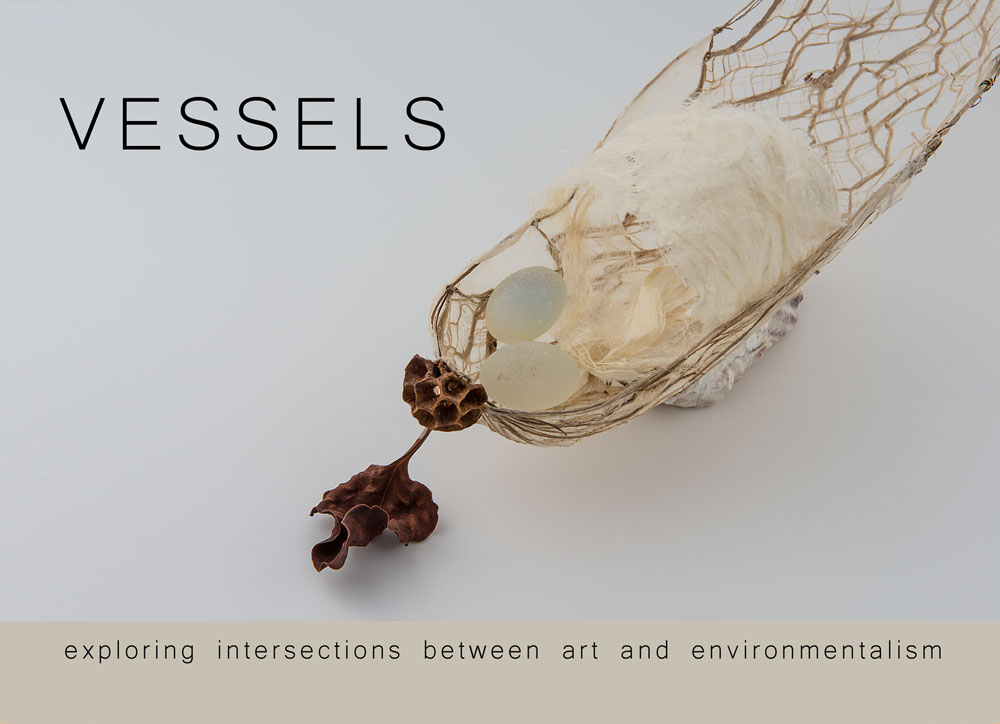Vessels
May 23 – June 23, 2013
Opening Reception: Saturday June 1, 7:00-9:00 PM
Family Art Day: Sunday June 9, 1:00-3:00 PM
Panel Discussion: Saturday June 15, 2:00-4:00 PM
Juried by Lawrence Rinder, Director of the Berkeley Art Museum and Pacific Film Archive, Vessels is an exhibition that explores the intersection between art and environmentalism with the vessel archetype. The vessel concept is one of our earliest learned ideas. It helps us make sense of our world as we begin to understand the difference between self and others, between inside and out. Vessels move through our landscape, and move us through it. Vessels contain and transport. Vessels take us places we have never been and bring us things from far away. Humanity shares this vessel planet, which contains us, nurtures us, and protects us from emptiness. The vessel is especially poignant given the locale of Arts Benicia, which is situated between the water and the land and the air, inhabiting a liminal boundary zone with refineries on one side and wilderness on the other.
Vessels includes the work of thirty-nine artists. Selected artists include: Lisa Aksen, Bobbie Altman, Kahalla Bandy-Pasibe, Nikki Basch-Davis, Lou Bermingham, Rennata Breth, Marla Brill, Kari Brink, Nancy Brown, Sarah Brown, Ken Chew, Carol Dalton, Hedi Desuyo, John Edwards, Heidi Endemann, Ann Holsberry, Madeleine Ibrahim, Leslie Jensen, Lisa Jetonne, Sandra Kozak, Barbetta Lockart, Jan F. Long, Scott MacLeod, Susan Marcus Sachs, Elisabeth McKinne, Chris Meade, Elaine Nehm, John Roloff, Monique Rutherford, Margo Scarpulla, Diana Shore, Lee Wilder Snider, Thomas Eric Stanton, Phyllis Thelen, James Thomas, Larry Thomas, Sandy Fong Whetstone, Sue Wilson, Maya WindDancer, and Jean Yates.
Lawrence Rinder stated: “The artists who submitted their work for consideration for this exhibition approach the theme of “vessel” in a variety of ways. There are, of course, those who delve into the word’s meaning as a container, jar, or amphora. Others gravitate to the image of a boat, in some cases in a form as prosaic as a canoe and in others in the profound sense of the spiritual ship that carries us all to the great beyond. Some artists interpreted the vessel as box, home, or plane. A few had no imagery at all but captured the sense of the vessel in terms of pure form, solely through arrangements of light and dark, color and shape. As an exhibition rooted in ecological awareness, it was important to me that all of these works, regardless of their explicit subject matter capture something that, to me, suggested the beauty and fragility of the world around us. Indeed many of these works express just such a feeling of delicate interconnection. My other criterion was artistic quality: I tried to select work that appeared to have the kind of visual strength and energy that made me want to keep looking.”
Funding for this exhibition and its programs has been provided by the Valero-Good Neighbor Fund in association with Benicia’s Community Sustainability Commission.
Photo by Michael VanAuken
Vessels
Juror: Larry Rinder, Director of Berkeley Art Museum and Pacific Film Archive
Pots, boats, bottles, bodies, our planet earth, a single cell; all are vessels. Vessels contain and transport. The vessel concept is one of our earliest learned ideas. It helps us make sense of our world as we begin to understand the difference between self and others, between inside and out. Vessels move through our landscape, and move us through it. Vessels take us places we have never been before and bring us things from far away. We all share this vessel planet that contains us, nurtures us, and protects us from emptiness. The vessel archetype is especially poignant given our locale, between the water and the land and the air; a boundary zone with refineries on one side and wilderness on the other.
Show opened: 5/23
Reception: 6/1, 7-9 pm
Panel discussion: Artists and Environmentalism, 2-4 pm, 6/15
Show closed: 6/23
Funding:
Funding is through Benicia Community Sustainability Commission to communicate realities about our shared Earth and its limited resources. The arts reach people in deep and meaningful ways that traditional modes of education and promotion cannot. Artists often address environmental concerns in their work through choice of materials and narrative content. Arts Benicia has a proud history of addressing environmental concerns with its exhibitions
About the Juror:
Larry Rinder is the Director of Berkeley Art Museum and Pacific Film Archive (BAM/PFA), a position to which he was appointed in 2008. Previously, he was the Dean of the College at the California College of the Arts in San Francisco. Rinder also served as the Anne and Joel Ehrenkranz Curator of Contemporary Art at the Whitney Museum of American Art where he organized exhibitions including “The American Effect,” “BitStreams,” the 2002 Whitney Biennial, and “Tim Hawkinson,” which was given the 2005 award for best monographic exhibition in a New York museum by the United States chapter of the International Association of Art Critics. Prior to the Whitney, Rinder was founding director of the CCA Wattis Institute for Contemporary Arts, in San Francisco, and served as Assistant Director and Curator for Twentieth-Century Art at the Berkeley Art Museum and Pacific Film Archive.
Among the many exhibitions he organized at these institutions are “Searchlight: Consciousness at the Millennium” (1999), “Knowledge of Higher Worlds: Rudolf Steiner’s Blackboard Drawings” (1997), “Louise Bourgeois: Drawings” (1996), “In a Different Light” (1995) “”Félix González-Torres” (1994), and “Where There Is Where There: The Prints of John Cage” (1989).
About the Gallery:
Arts Benicia’s pristine 2,000 square foot gallery is the focal point of a large artists’ community based in Benicia’s Historic Arsenal District. We leverage the talent and dedication of our member artists to serve the greater community, and we promote and advocate for the artists to the greater community as well.
Mission Statement:
“Arts Benicia’s mission is to stimulate, educate and nurture cultural life in Benicia through the visual arts. This community based non-profit organization provides exhibitions, educational programs, and classes that support visual artists and engage the broader community.”


